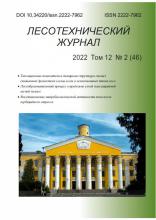g. Arhangel'sk, Russian Federation
In recent years, requirements of certification bodies and forestry authorities for developed to felling in terms of the number of undergrowth per unit area are increased. To save the undergrowth and reducing the area of damage to the surface cover cutting areas it is most advisable to use wide-feller bunchers, for example, ЛП-19, МЛ-119, Timberjack 850, John Deere 753J, John Deere 759J, etc.. Number of undergrowth largely depends on the development plan of cutting areas development. Known technological schemes are reviewed and analyzed. When hauling packs of trees at one spur track of forest road feller-buncher moves with the rapid moves, which reduce the efficiency of the development of cutting areas as a whole. When hauling trees packs at two spur track of logging roads two fold increase in the length of spur tracks is needed, which greatly increases the effort required to perform logging operations and the cost of production? New technologies for development of cutting areas are presented. In this case, traffic schemes of track feller buncher and skidder are the same as the known technology of timber harvesting without undergrowth preservation. Saving undergrowth is provided by changing the sequence of execution of elements of technological operation for forming full-load for bundles of trees for skidding. Upon developing cutting areas on the proposed technologies processes of formation of full-load skidding bundles of trees is accompanied by a rise of trees above the ground from packs formed by feller bunchers, and transfer them to skidding trails. Performance of skidder is defined. When comparing all the considered schemes to develop cutting areas several factors must be considered: load factor of skidder, distance of idling, duration of stacking trees in the forming device, possible change in the rate of tractor stroke due to the different download.
development of cutting areas, a pack of trees, feller-buncher, undergrowth, skidding, skidder.
1. A.s. 1303083 SSSR, MKI3 A 01 G 23/08. Sposob razrabotki lesosek [Tekst] / Derbin V.M. - № 3883737 ; zayavl. 10.04.1985 ; opubl. 15.12.1986, BI. - №14.
2. Vinogorov, G.K. Lesosechnye raboty [Tekst] / G.K. Vinogorov. - M. : Lesn. prom-st´, 1981. - 272 s.
3. Krugov, V.S. Valochno-paketiruyushchaya mashina LP-19 [Tekst] / V.S. Krugov, M.A. Bar-man, V.P. Ermol´ev, V.E. Korolev, B.V. Popov. - M. : Lesn. prom-st´, 1982. - 288 s.
4. Matveyko, A.P. Tekhnologiya i mashiny lesosechnykh rabot: Uchebnik dlya vuzov [Tekst] / A.P. Matveyko, A.S. Fedorenchik. - Mn.: Tekhnoprint, 2002. - 480 s. EDN: https://elibrary.ru/VWXMCL
5. Pravila zagotovki drevesiny. Utverzhdeny prikazom MPR Rossii № 184 ot 16.07.2007. [Elektronnyy resurs]. Rezhim dostupa: http://www.consultant.ru/document/cons_doc_LAW_124947/?frame=5
6. Shelgunov, Yu.V. Lesoekspluatatsiya i transport lesa [Tekst] / Yu.V. Shelgunov, A.K. Goryunov, I.V. Yartsev. - M. : Lesn. prom-st´, 1989. - 520 s.
7. Brokmeier, H. Struktur und Geschäftsfelder niedersächsischer Forstunternehmen [Text] / H. Brokmeier, M. Strunk. Forst und Technik, 2008. - rr. 24-27.
8. Drewes, D. Bestandesvorbereitung in der hochmechanisierten Holzernte [Text] / D. Drewes. - Forsttechnik, 2010. - 12 p.
9. Drushka, Ken Tracks in the Forest. The Evolution of Logging Machinery [Text] / Ken Drushka, Hannu Konttinen. - Timberjack Group. - Helsinki, 1997. - 253 p. ISBN 952-90-8616-4.
10. Fleischer, M. Geschichte der Holzernte in Handarbeit [Text] / M. Fleischer. - Proekte Verlag Cornelius GmbH, Halle/S. - 1. Auflage, 2009. - 212 p. ISBN 978-3-86634-664-2.
11. Fleischer, M. Geschichte der mobile Holzerntemaschinen [Text] / M. Fleischer. - Proekte Verlag Cornelius GmbH, Halle/S. - 1. Auflage, 2007. - 366 p. ISBN 978-3-86634-412-9.
12. Pausch, R. Die Holzernteplanung ersetzt den Zufall durch den Irrtum? [Text] / R. Pausch. - Forstmaschinenprofi, 2008. - pp. 58-61.












